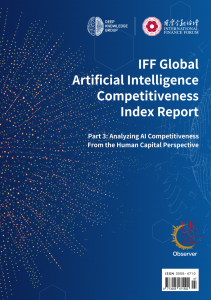Global AI Workforce Hits 3 Million, Yet 70 % Reside in Just Five Nations and G‑20 AI Talent Density Differs 50‑Fold
New IFF–DKG report shows the U.S and China alone account for 57 % of specialists, while eight of the top‑20 economies already report vacancy rates above 25 %.
A nation’s AI talent is its new strategic reserve. Those that secure it now will multiply gains in economy, defence and health, and those that ignore it will slide into a permanent second tier.”
LONDON, UNITED KINGDOM, July 28, 2025 /EINPresswire.com/ -- The International Finance Forum's Global AI Competitiveness Index Report Part III: Analyzing AI Competitiveness from the Human Capital Perspective, produced in collaboration with Deep Knowledge Group (DKG), offers the clearest picture to date of where the world’s artificial‑intelligence brain‑power is—and, just as critically, where it is not. — Dmitry Kaminskiy, General Partner at Deep Knowledge Group
After analysing more than 50 000 anonymised professional profiles and dozens of university‑pipeline and mobility datasets, the authors place the present global pool of AI practitioners at about three million. Yet the talent map is highly lopsided: five countries—the U.S., Mainland China, India, the U.K. and Canada—together employ 70 % of that total. Two of them, the U.S. and China, account for 57 %.
Density figures amplify the same story. The report measures the number of AI specialists for every million inhabitants across the G‑20 and discovers a fifty‑fold gap. Singapore tops the table at more than 7 500 per million; Brazil sits at fewer than 70. South Korea leads the G‑20 proper with 1 059 per million, while several large economies hover below 200. This disparity is not merely academic; AI talent operates as the raw fuel of national competitiveness, and nations that fail to cultivate or attract it will experience slower productivity growth, less economic stability, reduced capacity for technological sovereignty and waning geopolitical influence.
The consequences are already visible in labour‑market strain. By matching vacancy postings with available head‑count, the index finds that eight of the top‑20 economies suffer unfilled‑position ratios above 25 %. Employers in those markets are now importing specialists, automating less‑skilled tasks or postponing projects—outcomes that ultimately widen the performance gap between talent‑rich and talent‑poor nations.
While the US maintains an edge in absolute numbers and cross‑functional experience, the report shows Mainland China compressing time‑to‑expertise through a combination of state funding and repatriation schemes; 12 800 senior scientists have returned to China since 2018. India, despite a comparatively low density of 143 specialists per million people, is the world’s third‑largest source of AI manpower and the single biggest exporter of senior researchers to top U.S. laboratories. Japan and South Korea showcase an alternative template: smaller populations operating high‑intensity graduate‑school networks coupled to national semiconductor roadmaps, producing some of the highest per‑capita talent figures in the developed world. And in the Middle East, targeted visa reforms have propelled the UAE and Saudi Arabia into the global top‑20 for share and growth, underscoring how immigration policy can offset limited domestic pipelines.
That concentration of expertise sets up a cascading feedback loop. Regions with dense clusters attract more capital, frontier compute clusters and cutting‑edge research grants—factors that, in turn, pull in still more talent. Conversely, economies on the far end of the density spectrum risk a downward spiral: limited local mentors make it harder to scale graduate programmes, brain drain accelerates and corporate AI budgets migrate offshore.
Dmitry Kaminskiy, General Partner at Deep Knowledge Group, noted: “Because AI is a multiplier of every other technology, the human‑capital gap we see in this report will translate directly into widening divides in economic output, healthcare quality, defence readiness and even cultural reach. The next decade’s winners will be the nations that treat AI talent the way earlier eras treated oil or rare‑earth metals.”
Other novel findings include:
- Only 32.6 % of AI professionals occupy pure research or engineering posts; the majority operate in product, policy or business functions.
- 88 % hold a master’s degree or higher, and 80 % entered AI in the past three years, evidence of explosive post‑LLM growth.
- U.S. specialists cycle through 3.95 prior roles versus 2.91 in China, implying greater U.S. labour‑market fluidity.
- Saudi Arabia relies on foreign nationals for 65 % of its AI workforce, the highest import ratio among the G20.
The report concludes by urging policymakers to align immigration channels, compute infrastructure and cross‑disciplinary training if they wish to escape the gravitational pull of talent‑rich hubs. Whatever direction they choose, the numbers are stark: three million specialists for a technology expected to underpin every industry, and the vast majority sitting in just a handful of jurisdictions. In the emerging contest for economic and geopolitical influence, AI talent may prove the most decisive resource of all.
Access the report here: https://link.iff.org.cn/AIR3EN
Ian Inkster
Deep Knowledge Group (DKG)
info@dkv.global
Legal Disclaimer:
EIN Presswire provides this news content "as is" without warranty of any kind. We do not accept any responsibility or liability for the accuracy, content, images, videos, licenses, completeness, legality, or reliability of the information contained in this article. If you have any complaints or copyright issues related to this article, kindly contact the author above.

